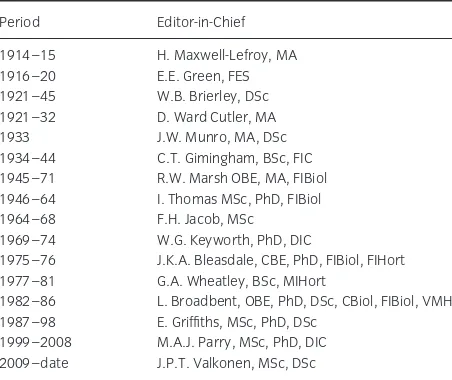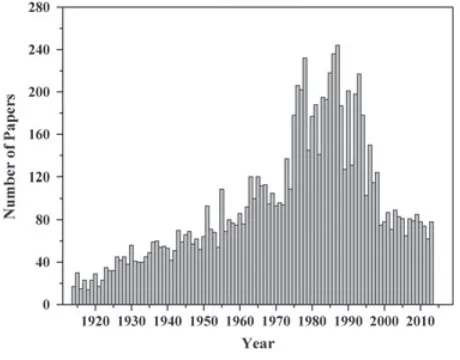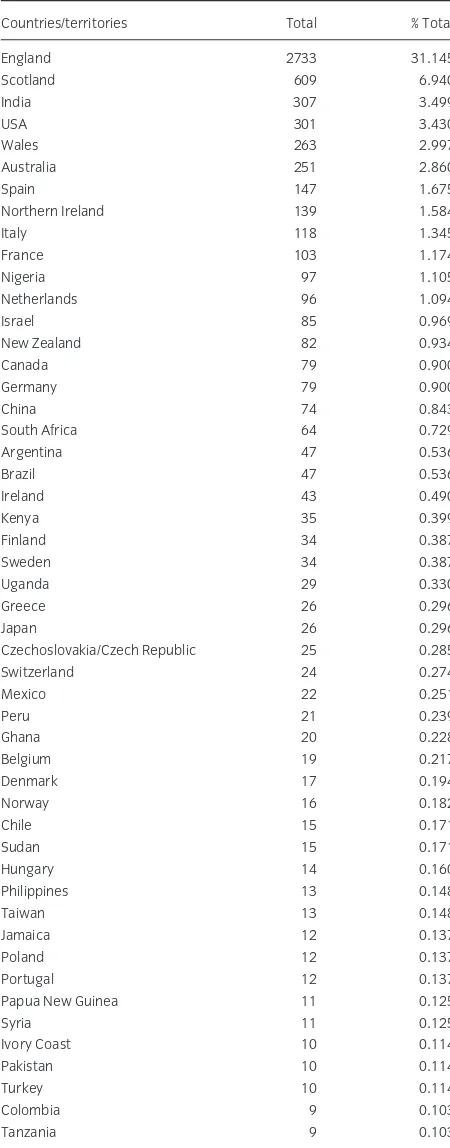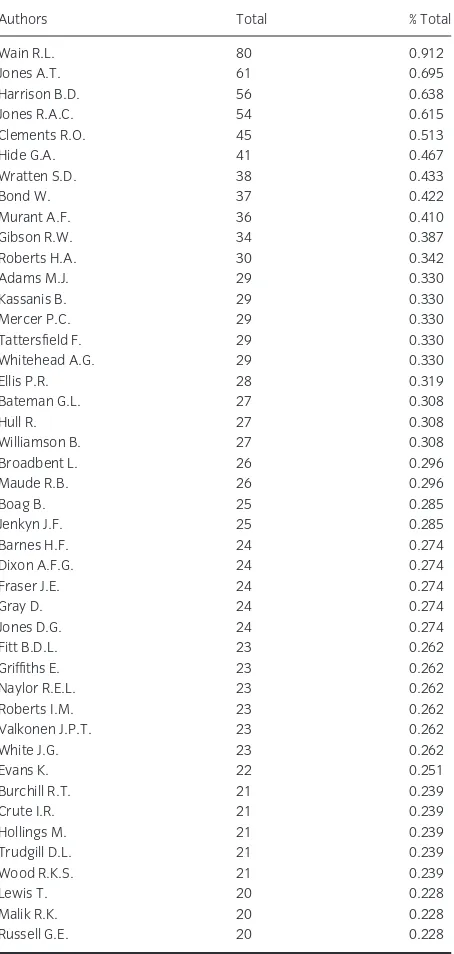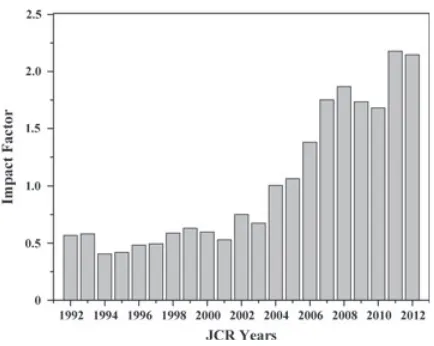Patron: Her Majesty The Queen Rothamsted Research Harpenden, Herts, AL5 2JQ
Telephone: +44 (0)1582 763133 Web: http://www.rothamsted.ac.uk/
Rothamsted Research is a Company Limited by Guarantee
Rothamsted Repository Download
A - Papers appearing in refereed journals
Azevedo, R. A., Lea, P. J., Leather, S. R., Mcnichol, J. W., Millman, C. A.,
Haslam, R. P. and Valkonen, J. P. T. 2014. The centenary of Annals of
Applied Biology in 2014. Annals of Applied Biology. 164 (1), pp. 1-7.
The publisher's version can be accessed at:
•
https://dx.doi.org/10.1111/aab.12093
The output can be accessed at:
https://repository.rothamsted.ac.uk/item/8qz43
.
© 9 December 2013, Wiley.
C E N T E N A R Y E D I T O R I A L
The centenary of
Annals of Applied Biology
in 2014
R.A. Azevedo1, P.J. Lea2, S.R. Leather3, J.W. McNicol4, C.A. Millman5, R.P. Haslam6& J.P.T. Valkonen7
1 Departamento de Gen ´etica, Escola Superior de Agricultura Luiz de Queiroz, Universidade de S ˜ao Paulo, Piracicaba, SP, Brazil 2 Lancaster Environment Centre, University of Lancaster, Lancaster, UK
3 Department of Crop and Environment Sciences, Harper Adams University, Edgmond Newport, Shropshire, UK 4 Biomathematics & Statistics Scotland, BioSS Office, The James Hutton Institute, Dundee, Scotland, UK 5 The Association of Applied Biologists, Warwick Enterprise Park, Wellesbourne, Warwick, UK 6 Biological Chemistry & Crop Protection, Rothamsted Research, Harpenden, UK
7 Department of Agricultural Sciences, University of Helsinki, Helsinki, Finland
Correspondence
J.P.T. Valkonen, Department of Agricultural Sciences, University of Helsinki, PO Box 27, Helsinki FI-00014, Finland.
Email: jari.valkonen@helsinki.fi
doi:10.1111/aab.12093
Annals of Applied Biology(Annals) has published the results of original research in applied biology for 100 years. The journal was established because of the need for a more efficient distribution of scientific information of applied importance, especially in agriculture and horticulture. Over the years, most papers in Annals have reported on crop science, horticulture, pests and diseases of field crops and horticultural plants, and plant breeding. The scope of the journal has remained consistent, although currently the research fields covered in Annals can also be described using the terms agriculture and the environment, crop improvement, pest and invertebrate biology, and plant–pathogen interactions. Maintaining high standards of statistical analysis in the papers published has always been emphasised inAnnals.
The Centenary of Annals in 2014 will be celebrated by highlighting some of the most influential papers published in the journal over the 100 years. These papers have been selected by the Senior Editors (the authors of this editorial), following consultation of the Editorial Board of Annals, which consists of scientists from all parts of the world. Each issue of Annals in 2014 will contain at least one Centenary editorial that introduces an influential paper. Furthermore, the same issue will contain a solicited review article related to the influential paper. The first influential paper introduced in this issue is the study by Chester I. Bliss (1935) on the calculation of the dosage-mortality curve, which has been cited over 850 times and is still regularly referred to today. The editorial has been written by David Finney, who knew Bliss personally and who acted as an unofficial statistical editor of the journal during the period 1942–54. It is noteworthy that this editorial
marks 76 years since David Finney’s first publication in 1938 (Finney, 1938). The review article has been written by Roger Payne, who was the Senior Statistical Editor of Annalsfrom 1980 to 1989. The editorials, influential papers and review articles will be made available for free access on the home page ofAnnals(http://onlinelibrary. wiley.com/journal/10.1111/(ISSN)1744-7348).
The Association of Applied Biologists (Association) will organise a Centenary conference under the title ‘Sustain-able Intensification’ in December 2014. For details of the programme and other details, please refer to the home page of the Association in the near future (http://www. aab.org.uk/).
In the following sections we provide some perspectives as to the development ofAnnalsas a scientific journal and statistical data on its impact in the field of applied biology.
How it all began
Centenary ofAnnals R.A. Azevedoet al.
Table 1 List of Editors-in-Chief ofAnnals of Applied Biology1914–2013
Period Editor-in-Chief
1914–15 H. Maxwell-Lefroy, MA 1916–20 E.E. Green, FES 1921–45 W.B. Brierley, DSc 1921–32 D. Ward Cutler, MA 1933 J.W. Munro, MA, DSc 1934–44 C.T. Gimingham, BSc, FIC 1945–71 R.W. Marsh OBE, MA, FIBiol 1946–64 I. Thomas MSc, PhD, FIBiol 1964–68 F.H. Jacob, MSc 1969–74 W.G. Keyworth, PhD, DIC
1975–76 J.K.A. Bleasdale, CBE, PhD, FIBiol, FIHort 1977–81 G.A. Wheatley, BSc, MIHort
1982–86 L. Broadbent, OBE, PhD, DSc, CBiol, FIBiol, VMH 1987–98 E. Griffiths, MSc, PhD, DSc
1999–2008 M.A.J. Parry, MSc, PhD, DIC 2009–date J.P.T. Valkonen, MSc, DSc
had indeed formed an association in 1904 ‘to make themselves felt’, a journal was also needed to strengthen the organisation. It was noted that the scientific libraries contained literature on basic science, but ‘scarcely any at all of the applied aspects’ (Maxwell-Lefroy, 1914). For an interesting analysis of the ‘Pragmatism, Patronage and Politics’ in applied/economic biology up until 1920, the reader should refer to Kraft (2004).
Six hundred copies were subsequently printed and published in May and the invoice from CUP for production and distribution was £240 and 9 pence. Considering that costs through inflation have risen almost a 100-fold since 1914, this may seem a large amount of money to spend on a fledgling journal, but a similar amount was considered appropriate for the launch of thePlant Biotechnology Journalby the Association and the Society for Experimental Biology (SEB) in 2003.
The timing of the initial launch of the journal was unfortunate, as it was on the eve of the First World War, and it was a struggle to keep the journal financially viable for the duration of the war, 1914–18, and for several years afterwards. This was despite securing grants from various august bodies and authors being encouraged to contribute ‘grants in aid of publication’, more commonly known as publication charges today. The size of the journal grew considerably during the 1920s and on into the 1930s due to the increased number of submissions, however, this often caused delays in publication. During World War II (1939–45), publication of Annals continued despite considerable difficulties. Publication during this period was primarily limited by the availability of paper and a shortage in printing compositors. In order to mitigate these issues, the quality of paper was reduced and a two column smaller print format was adopted.
Following the end of World War II and into the 1950s, the interval between submission and publication became longer and the financial state of the journal deteriorated. For 4 years, only members of the Association were able to submit manuscripts. In 1961, however, the new treasurer Frank Raw proposed that back issues ofAnnalsshould be reprinted and made available to new University libraries. This proved to be an extremely successful venture and greatly improved the finances of the Association. In 1963, the single four-part volume was expanded to the current two three-part volumes. In 1969, a Board of Editors was formally established, comprising 20 scientists with a wide range of expertise, which included statistical consultants (today the Editorial Board consists of 60 members and includes several statistical editors). In 1972, the Association in conjunction with The Biochemical Society took over responsibility for publishing the journal, although CUP still carried out the printing. Stimulated by the purchase of an Apple Computer in 1981 (probably worth a lot of money now as an antique), computer typesetting ofAnnalswithin the office of the Association began in 1984. Shortly after this in 1985, the office took over the distribution and marketing ofAnnals from the Biochemical Society, which required additional staff time and the purchase of more computers. The history of the journal has proved fairly easy to trace as previous Editors have written similar articles inAnnalsto commemorate the 25th anniversary (Brierley, 1939), the golden jubilee of the Association (Marsh, 1953), the first 100 volumes (Wheatley, 1982) and the 75th anniversary (Griffiths (1989); while for the centenary of the Association, a separate volume was compiled (Langtonet al., 2004). We are very grateful to these authors for providing the source material for this historical section.
Although the number of papers published was at its highest in the 1980s and well into the 1990s (Fig. 1), the number of library subscriptions forAnnalsfell from 943 in 1990 to 551 in 1999 and to 429 in 2004. Finally, the decision was taken in 2004 for production, marketing, sales and distribution to be undertaken by Blackwell Publishing, although Annals was still to be owned by the Association. This was a very important decision and required a considerable amount of negotiation between members of the Council, Blackwell and Martin Parry who was then the Editor-in-Chief. Subsequently, Blackwell Publishing was acquired by John Wiley & Sons and merged to form Wiley-Blackwell in 2007 and it is now known as Wiley. Annals first became available online in 2000 and can now be accessed through the Wiley Online Library http://onlinelibrary.wiley.com/journal/ 10.1111/(ISSN)1744-7348/issues.
Figure 1The number of papers published inAnnals of Applied Biology
in the years 1914–2013, data obtained from Web of Science (WoS, http://thomsonreuters.com/web-of-knowledge). For the period 1955–60, the numbers have been taken directly from the Wiley online records of the journal (http://onlinelibrary.wiley.com/journal/10.1111/(ISSN)1744-7348/issues), as they are not available in the WoS database.
The ScholarOne online system, employed for the submis-sion and reviewing of manuscripts, which has now been in use for over a decade, has proved to be particularly use-ful and efficient. The Editorial Office ofAnnalsis currently run by Carol Millman (Editorial Administrator), assisted by John Andrews, both in the office of the Association at Wellesbourne. The other key persons in producing the journal are the copy editor, Philip Smith at the James Hutton Institute; Felicity Clark at Wiley, Oxford; Paula Alcantara at the Wiley production office in Singapore; and Ramkumar Palani at Laserwords.
Metrics and impact
In order to provide an analysis of the papers published in
Annalsover the 100 years and to enable the preparation of this editorial in time for the first issue of the Centenary 2014, the data used in the following analyses only includes up to the last week of July 2013, and the last two issues of 2013 have not been included. Taking the last two issues into consideration, however,Annalshad published 8804 papers in the 100 years. The term ‘paper’ will be used to include all forms of publications, such as research papers, review articles, conference proceedings, etc.
There are a variety of literature databases available that could be used for the analysis, but only Web of Science (WoS), which is part of Thomson Reuters Web of Knowledge (http://thomsonreuters.com/web-of-knowledge) covers the whole period of 100 years. Unfortunately, information about papers published in
Table 2 The numbers of different types of papers published inAnnals of Applied Biologyfrom 1914 until 31 July 2013. Data are from the Web of Science (WoS)a
Papers Total % Total
Research article 7910 90.142
Meeting abstract 463 5.276
Note 148 1.687
Review 102 1.162
Editorial material 58 0.661
Correction addition 31 0.353
Book review 30 0.342
Proceedings paper 22 0.251
Item about an individual 22 0.251
Biographical item 5 0.057
Correction 4 0.046
Reprint 2 0.023
Total 8775 100
aThe two last issues of 2013, volume 163, contained 24 research articles, 1 review article and 3 editorials, resulting in a total of 8804 papers published in 100 years.
Annals during the period 1955–60 is not available in the WoS scientific literature database, for unknown reasons. Copies of all papers published in Annals can, however, be obtained from the journal homepage (http://onlinelibrary.wiley.com/journal/10.1111/(ISSN) 1744-7348/issues).
The first volume of Annals in 1914 contained two issues and a total of 210 pages. In the ‘Notes’ published in that year, ‘The Scope of the Annals’ as decided at the Association meeting held in London on April 17th and 18th was made available to readers. From that year,
Annals has been published regularly and still is today. As shown in Table 2, a search in WoS indicates the presence of 8775 publications since 1914 until July 2013 (all papers are in the ‘Agriculture – Multidisciplinary’ WoS category), of which 90% are classified as research papers. In the recent past,Annalshas published mainly research articles, reviews and editorials, and other forms of publications have been rare. For example, short communications are no longer published.
Centenary ofAnnals R.A. Azevedoet al.
This trend is in contrast to the number of submitted manuscripts, which has more than doubled. A total of 172 manuscripts were submitted in 2004, compared with 406 papers submitted in 2012. As a consequence, a lower proportion of the submitted manuscripts, that is, only the most novel and significant papers can be accepted for publication and the acceptance rate now stands at 25%. The average time from receipt of a manuscript to first decision is currently 27 days.
Over the years, the number of countries, from which submissions are received, has increased greatly (Table 3). At the time of the launch ofAnnals, the Editor encouraged members of the Association to submit papers from all parts of the Empire (Maxwell-Lefroy, 1914). Today, less than half (42%) of the papers include authors at institutes in the United Kingdom. The 8775 papers published in
Annalshave been written by 9325 different authors from 134 countries and all continents.
Among the 9325 different authors who have published papers in Annals, there are 70 authors who have contributed at least 18 papers and 11 authors who have contributed over 30 papers (Table 4). R. Louis Wain (not to be confused with the artist who painted cats) has published by far the highest number of papers (80; 0.912%). Louis Wain has been described as ‘the most outstanding agricultural chemist of the 20th century’ (Fowden, 2002). His initial research was on plant growth regulators, which was extended to the synthesis of a group of highly selective herbicides, some of which are still used today.
Taking into consideration ‘Organisations’ of authors, as indicated in the WoS database, 8775 papers were contributed from 1779 different organisations (Table 5). The actual number of organisations is, however, lower because the WoS analysis does not take into account changes in the name of the same organisation. Despite this, the total number of organisations is still quite high. Furthermore, the term ‘Organisations’ used by WoS includes the name of research institutes, but often also the government departments that are accountable for them. Organisations such as Agricultural Development Advisory Service (ADAS), Agricultural and Food Research Council (AFRC), Commonwealth Scientific and Industrial Research Organisation (CSIRO), Institut National de la Recherche Agronomique (INRA) and Ministry of Agriculture, Fisheries and Food (MAFF) have not been taken into account in our analysis, because they are often responsible for a large number of research institutes.
Most of the research institutes that have contributed the greatest number of papers toAnnalsover the years are located in the United Kingdom (Table 5). Many of them have been closed down or merged in the recent past. For instance, Rothamsted Experimental Station merged
Table 3 The geographical distribution and number of authors who have published papers inAnnals of Applied Biology(from 1914 until 31 July 2013). The 50 countries with the highest number of authors are listed. Data are from the Web of Science (WoS)
Countries/territories Total % Total
England 2733 31.145
Scotland 609 6.940
India 307 3.499
USA 301 3.430
Wales 263 2.997
Australia 251 2.860
Spain 147 1.675
Northern Ireland 139 1.584
Italy 118 1.345
France 103 1.174
Nigeria 97 1.105
Netherlands 96 1.094
Israel 85 0.969
New Zealand 82 0.934
Canada 79 0.900
Germany 79 0.900
China 74 0.843
South Africa 64 0.729
Argentina 47 0.536
Brazil 47 0.536
Ireland 43 0.490
Kenya 35 0.399
Finland 34 0.387
Sweden 34 0.387
Uganda 29 0.330
Greece 26 0.296
Japan 26 0.296
Czechoslovakia/Czech Republic 25 0.285
Switzerland 24 0.274
Mexico 22 0.251
Peru 21 0.239
Ghana 20 0.228
Belgium 19 0.217
Denmark 17 0.194
Norway 16 0.182
Chile 15 0.171
Sudan 15 0.171
Hungary 14 0.160
Philippines 13 0.148
Taiwan 13 0.148
Jamaica 12 0.137
Poland 12 0.137
Portugal 12 0.137
Papua New Guinea 11 0.125
Syria 11 0.125
Ivory Coast 10 0.114
Pakistan 10 0.114
Turkey 10 0.114
Colombia 9 0.103
Table 4 Authors who have published at least 20 papers inAnnals of Applied Biology(from 1914 until 31 July 2013). Data are from the Web of Science (WoS)
Authors Total % Total
Wain R.L. 80 0.912
Jones A.T. 61 0.695
Harrison B.D. 56 0.638
Jones R.A.C. 54 0.615
Clements R.O. 45 0.513
Hide G.A. 41 0.467
Wratten S.D. 38 0.433
Bond W. 37 0.422
Murant A.F. 36 0.410
Gibson R.W. 34 0.387
Roberts H.A. 30 0.342
Adams M.J. 29 0.330
Kassanis B. 29 0.330
Mercer P.C. 29 0.330
Tattersfield F. 29 0.330
Whitehead A.G. 29 0.330
Ellis P.R. 28 0.319
Bateman G.L. 27 0.308
Hull R. 27 0.308
Williamson B. 27 0.308
Broadbent L. 26 0.296
Maude R.B. 26 0.296
Boag B. 25 0.285
Jenkyn J.F. 25 0.285
Barnes H.F. 24 0.274
Dixon A.F.G. 24 0.274
Fraser J.E. 24 0.274
Gray D. 24 0.274
Jones D.G. 24 0.274
Fitt B.D.L. 23 0.262
Griffiths E. 23 0.262
Naylor R.E.L. 23 0.262
Roberts I.M. 23 0.262
Valkonen J.P.T. 23 0.262
White J.G. 23 0.262
Evans K. 22 0.251
Burchill R.T. 21 0.239
Crute I.R. 21 0.239
Hollings M. 21 0.239
Trudgill D.L. 21 0.239
Wood R.K.S. 21 0.239
Lewis T. 20 0.228
Malik R.K. 20 0.228
Russell G.E. 20 0.228
with the Long Ashton Research Station and Broom’s Barn Experimental Station in 1987 to form the Institute of Arable Crops Research, Rothamsted. The latter name was subsequently changed to Rothamsted Research in 2002. Similarly, the James Hutton Institute was formed by a merger of the Macaulay Land Use Research Institute and the Scottish Crop Research Institute in 2011. The latter was formed in 1981 following amalgamation of
Table 5 Institutes (organisations) which have affiliated the highest numbers of authors who have published papers inAnnals of Applied Biology(from 1914 until 31 July 2013). Unless the country is shown, the institutes are located in the UK. Data are from the Web of Science (WoS). Some of the institutes have been merged recently
Institutions Number of papers % Total
Rothamsted Experimental Station 329 3.749 Scottish Crops Research Institute 286 3.259 National Vegetable Research Station 264 3.009 University of Reading 119 1.356 University of Bristol 113 1.288 East Malling Research Station 112 1.276 Welsh Plant Breeding Station 103 1.174 Glasshouse Crops Research Institute 93 1.060 Horticultural Research Institute 88 1.003 University of London 59 0.672 Queens University Belfast 58 0.661 Aligarh Muslim University, India 53 0.604 Scottish Horticultural Research Institute 52 0.593 Broom’s Barn Experimental Station 51 0.581 University of Nottingham 50 0.571
Rothamsted Research 49 0.558
Haryana Agricultural University, India 46 0.524 University of Southampton 44 0.501 University College North Wales 38 0.433
IACR Rothamsted 37 0.422
University of Leeds 36 0.419
University of Adelaide, Australia 35 0.399
University of Wales 30 0.342
Scottish Agricultural College 29 0.330 University of Western Australia 29 0.330
the Scottish Plant Breeding Station and the Scottish Horticultural Research Institute. This makes a detailed analysis of the information available in Table 5 difficult. Taking into account the mergers listed above, the two top institutes contributing the highest number of publications to Annalsare Rothamsted Research (415; 4.729%) and the James Hutton Institute (384; 4.376%).
Centenary ofAnnals R.A. Azevedoet al.
Figure 2The number of citations for papers published in Annals of Applied Biologyfrom 1914 until 31 July 2013 [data are from Web of Science (WoS)]; 104 760 citations were listed forAnnalspapers by using the ‘Citation Report’ tool in WoS. The citations for papers published in 1955–60 are included. In contrast, an additional 14 174 citations were identified using the ‘Cited Reference Search’ analysis system, but these citations were not included in the Citation Report because of the mistakes made in papers that cited the papers ofAnnals. Spelling errors of author’s names, volume numbers, issue numbers, page numbers and the year of publication were some of the mistakes most frequently encountered. The combined data indicate a total of 118 934 citations forAnnals.
Citation analysis based on data in WoS shows that altogether, papers published in Annals have received a total of 104 760 citations (Fig. 2), that is, on average 11.94 citations per paper resulting in a h-index of 85. Only 15.2% of the papers published have never been cited. The most cited paper was written by Chester Bliss (1935) on the calculation of the dose-mortality curve and has been cited 856 times.
The Impact Factor (IF) of a journal is based on the average number of citations received per paper published in the journal during the two preceding years. TheJournal Citation Reports(JCR; http://thomsonreuters.com/journal-citation-reports) publishes the IF in June each year. The development of the IF ofAnnalsis shown in Fig. 3. The data show an increasing trend of IF, since it was first pub-lished in 1992, from 0.567 to 2.147 in 2012. The IF value passed 1.0 in 2004 and 2.0 in 2011. If we consider the IF value as an indicator of the relative scientific impor-tance of a journal within its field,Annalshas been ranked continuously third to fifth among the journals in the Agri-culture – Multidisciplinary subject category since 2004 (Table 6). It is important to note that in 2004 there were 29 journals in the subject category, whereas since then, the number of journals has almost doubled and reached 57 in 2012. These developments have caused a continu-ous increase in the number of citations and IF values of journals, but also an increase in the overall quality of the
Figure 3Impact Factor (IF) of papers published inAnnals of Applied Biologybetween 1992–2012. Data are from theJournal Citation Reports
(JCR, http://thomsonreuters.com/journal-citation-reports)
papers and journals. For instance in 2004, only 2 of (6.9%,
Annalsincluded) 29 journals in the subject category had an IF value above 1.0 and only one journal (3.4%) had an IF above 2.0. Data from the current version of theJCR
(2012) show that presently 14 (24.6%) of 57 journals in the subject category have IF values above 1.0 and four journals (7%) have IF values above 2.0,Annalsincluded.
Annalspublishes results of applied research, or research whose applications in agriculture are obvious. Therefore, the IF value is not the only indicator of usefulness of the information published in the journal, because many users of information are not research scientists, but specialists in agriculture and other fields of applied biology. They may frequently study the papers published in Annals, but do not write and publish scientific papers in journals included in WoS and hence do not contribute to the IF. A large number of readers of Annals belong to this important other category of users. This is indicated by the 93 881 full text article downloads fromAnnalsin 2012. AsAnnalsbecame available on-line, the numbers of full papers downloaded has increased by 10–15% per year.
Today,Annalsis available in 4300 institutions world-wide, including 2645 institutions in the developing world via philanthropic initiatives.
The future
Table 6 Rank ofAnnals of Applied Biologyin theJournal Citations Reportssubject category Agriculture – Multidisciplinary
2004 2005 2006 2007 2008 2009 2010 2011 2012
Rank (position in table/number of journals) 3/29 3/31 3/31 3/35 3/35 4/44 5/55 4/57 5/57
climate will make such challenges even more difficult to overcome. Many important applications are based on the results of basic research carried out in molecular biology, and many current key issues relate to the impact of agriculture on the environment, as predicted by Griffiths (1989) at the time of the 75th anniversary of theAnnals. In many traditional fields of applied biology, for example, the diagnostics of plant pathogens, the use of molecular techniques, such as the polymerase chain reaction (PCR), is now commonplace. Understanding the interactions between plants, insects, microbes and abiotic factors is essential if we are to be able to manage crops in the field and greenhouse. It is not the methodology, but the applied aspects of research from agricultural and horticultural perspectives, that will continue to define the scope ofAnnalsin the future.
Electronic publishing has changed many technical aspects of the production of manuscripts and scientific journals within a short period of time. Preparing, submitting and handling papers are now much easier, and the published information is available more readily than ever before. Annals has taken advantage of all these positive developments, with invaluable support obtained from the publisher, Wiley. The basic principle of using peer review, as the means to ensure quality and originality of the information published has, however, not changed. It is therefore our belief that journals paying proper attention to such quality aspects will continue to be popular and readers will rely on them as sources of reliable information. Annals has a long tradition in publishing qualified papers in applied biology, and the Editors and the Association are committed to maintaining good scientific practice. In this way, the journal will continue to disseminate novel, interesting and useful results to the global readership.
We would like to extend our gratitude to the whole production team and the Editorial Board of Annals,
the authors who have submitted their interesting and significant papers to the journal, the reviewers ofAnnals
for their dedicated work on the manuscripts, and all subscribers ofAnnalsfor your continuing support.
References
Bliss C.I. (1935) The calculation of the dosage-mortality curve.Annals of Applied Biology,22, 134–167.
Brierley W.B. (1939) The Association of Applied Biologists and The Annals of Applied Biology – a retrospect (1904–1938).Annals of Applied Biology,16, 178–195. Finney D.J. (1938) The distribution of the ratio of estimates
of the two variances in a sample from a normal bivariate population.Biometrika,30, 190–192.
Fowden L. (2002) Ralph Louis Wain, C.B.E. 29 May 1911–14 December 2000. Biographical Memoirs of the Fellows of the Royal Society,48, 439–458.
Griffiths E. (1989) 75thanniversary of theAnnals of Applied
Biology.Annals of Applied Biology,115, 1.
Kraft A. (2004) Pragmatism, patronage and politics in English biology. The rise and fall of economic biology 1904–1920.
Journal of the History of Biology,37, 213–258.
Langton F.A., Thompson A.R., Millman C.A. (2004)
Association of Applied Biologists 1904–2004: A Celebra-tion of Achievement. Wellesbourne, UK: Association of Applied Biologists, pp. 112. URL http://www.aab.org.uk/ contentok.php?id=308.
Marsh R.W. (1953) The past and the future of the Annals of Applied Biology.Annals of Applied Biology,40, 435–448. Maxwell-Lefroy H. (1914) The Annals of Applied Biology.
Annals of Applied Biology,1, 1–4.
